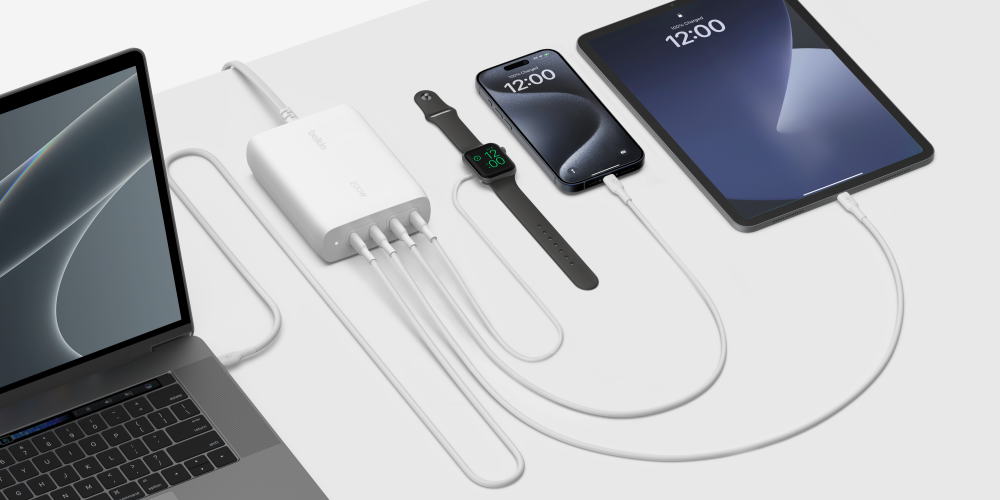The Battle of Convenience: Wireless vs. Wired Phone Charging
May 28, 2024
Ever stop to think about the way you charge? Do you prefer wired or wireless? What’s the difference between the two, and which one is best for you? Let’s dive into the benefits of each.
Wireless Charging
What is wireless charging? Also known as inductive wireless charging, this is a fuss-free, cable-free way to charge your device. The two most notable wireless charging technologies are MagSafe and Qi2, which both use magnets to provide a secure, power-efficient way to wirelessly attach chargers to smartphones, while delivering faster charging speeds.
Advantages:
- Convenience: No need for extra gear, simply place the device on a charging pad.
- Reduced wear and tear: Eliminates the wear on charging ports caused by plugging and unplugging cables.
- Aesthetics: Allows for sleek and minimalistic designs without visible cables.
Limitations:
1) Slower charging speeds: When charging wirelessly, you may notice that the device and the charger begin to feel warm. This is due to power dissipation, caused by electromagnetic losses. Some energy is lost when heat is generated, slowing down the charging rate. Belkin products are always built with safety and performance in mind – with Belkin, expect thermal protection systems to control temperatures and prevent overheating and enhanced foreign object detection to ensure that only compatible devices are charged, minimizing the risk of accidents or damage.
- Thanks to wireless charging technology MagSafe and Qi2, which cleverly uses magnets to ensure a fast and efficient charge, wireless charging is now more efficient and creates far less heat. While the device is still connected to the charger, the charging coils stay aligned properly.
- Qi2 aims to optimize energy usage, minimize charge times, and safeguard the device's battery life and integrity. Only Qi2 certified devices will work. If it isn't certified, performance may vary.
2) Limited range: Devices need to be perfectly aligned on the charging pad for the charge to start.
3) Compatibility: Not all devices support wireless charging.
Belkin Safety
Belkin adheres to the highest quality standards during the engineering process to ensure your Belkin products are safe, long-lasting, and effective. Created with careful craftsmanship and sustainable and durable materials, like stainless steel, silicone, and polycarbonate, you’re less likely to encounter issues with Belkin than with many other wireless charger providers.

Wired Charging
What is traditional wired charging? Wired charging is a fail-safe way to power up your device at the fastest speeds. The most notable wired charging technologies include: USB-C, fast charging and GaN.
Advantages:
- Faster charging speeds: Even with the higher wattages available, wired chargers don’t transfer generated heat to the charged device because they are separated by the cable that connects them. While a wired charger will heat up the phone, it does so at a lower rate. Belkin chargers go through a rigorous testing process and are built with high quality materials to assure safety with overcharge and overvoltage protection.
- If your device is PD enabled, look out for integrated PD3.0 PPS technology which provides safe high-speed charging to almost all USB and PD-enabled devices.*
- Wide compatibility: Works with virtually all smartphones and devices.
- Reliability: Ensures a stable and consistent charging connection.
Limitations:
- Cable clutter: Requires cables that can become tangled and messy.
- Wear and tear: Plugging and unplugging cables can cause damage to charging ports over time.
- Limited mobility: Users must remain close to power outlets while charging.
Example
For reference, we compared charging a Samsung Galaxy S24 from 0 – 100% with a Belkin 15W wireless charging pad, to a Belkin 20W USB-C PD wall charger with PPS. The results:
- 15W charging pad – 2hr 15min
- 20W wall charger – 1hr 17min
Use cases for wireless charging
- Convenience: Wireless charging is a great way to remove clutter from your desk space, nightstand, kitchen counter, etc.; and some, like Belkin's MagSafe collection, are beautifully designed to blend into or accent your environment.
- Personalization: Wireless charging is universally compatible with most Android and iPhone devices, making it easy to use, not having to worry about USB-C versus Lightning ports.
Use cases for wired charging
- Quick charge: Wired charging is best if you need a quick power-up before going out or need to charge power-hungry devices like laptops or tablets. You can find high-powered wall chargers with multiple ports to simultaneously fast charge 2 or more devices.
*To note: charge times of the wall charger also depend on wattage. It will charge slower with a 12W USB-A charger for example; and will charge faster with 30W charger.
Shop Wireless Chargers
Shop USB-C Chargers
Shop Wireless Chargers
Shop Wired Chargers
We hope you enjoyed this post. Signup for blog alerts, product announcements, and exclusive deals via emails and texts now.













+Bundle_NPI_gallery.jpg?sw=280&sh=280&sm=fit&sfrm=png)

